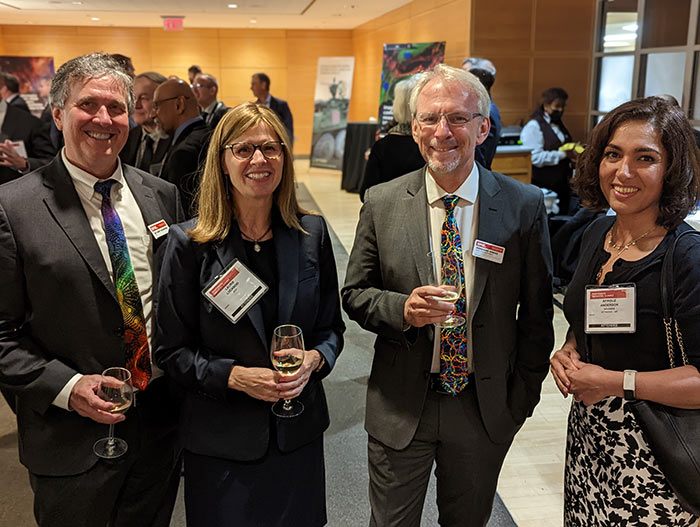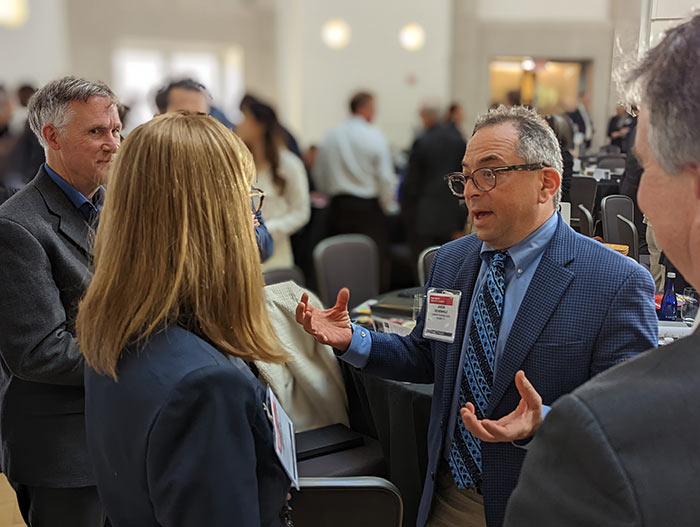Photonics industry leaders converged with government officials and policymakers in Washington, D.C., on Sept. 21 to attend SPIE’s inaugural Photonics Industry Summit. The summit kickstarted conversations about the shared goals and challenges of government and industry leaders — particularly with regard to the recently passed CHIPS and Science Act, workforce development, and the impact of export controls on international commerce.
“I am delighted SPIE gathered so many optics and photonics industry executives and government leaders together for the first time, here in Washington, D.C.,” said Kent Rochford, SPIE CEO. “In response to historic legislation that expands opportunities for our field, we created an opportunity for dialogue and connections with government leaders and other executives, connections that are vital for business and government relations.”
With the implementation of the CHIPS and Science Act top of mind, the summit allowed industry players to discuss topics pertaining to all levels of the photonics value chain — from R&D to established challenges within the workforce.
“Workforce remains a key area of focus, and the ways that we in industry communicate about that issue and act to address it are going to continue to shift as this legislation is enacted,” said Jay Kumler, president of JENOPTIK North America Inc., speaking to Photonics Media.
“Many of the concerns and the focal points that we in industry see are shared by all of us, so there is value in being together to discuss how we look at the current environment and share that with stakeholders from different points in the ecosystem and hear how they are looking at it,” Kumler said.
Industrial policy
Kei Koizumi, principal deputy director for policy for the White House Office of Science and Technology Policy, set the tone for the day’s discussions by walking attendees through R&D funding opportunities supported by the CHIPS and Science Act, as well as workforce development funding and partnerships through the National Science Foundation (NSF). His presentation sparked the first of several mentions throughout the day about the *looming expiration of the Small Business Innovation Research (SBIR) and Small Business Technology Transfer (STTR) programs, for which congressional authorization is set to expire at the end of the fiscal year on Sept. 30, but could be extended.

Attendees from government, industry, and academia attended the SPIE Photonics Industry Summit Sept. 21 in Washington, D.C. From left, SPIE CEO Kent Rochford; NIST Director Laurie Locascio; Google’s director for optical engineering, AR hardware and SPIE president elect Bernard Kress; and National Institute of Biomedical Imaging and Bioengineering (NIBIB) program director Afrouz Anderson. Courtesy of SPIE.
NIST director Laurie Locascio’s presentation deepened the focus on the CHIPS and Science Act and the role NIST is to play in leading the directives outlined by the government in the $52 billion appropriations bill. Locascio further shared a breakdown of the funding plans for CHIPS for America programs, which includes $39 billion for manufacturing and $11 billion for up to four distinct R&D centers.
Amid heightened global competition, rising national security interests, and a war in Europe, U.S. government export control officials must maintain an ever more delicate balancing act between fostering innovation and ensuring national security. Presenter Thea Rozman Kendler, assistant secretary of commerce for export administration in the Bureau of Industry and Security (BIS), exhibited a version of that balancing act by outlining the government’s review and control policies for U.S. exports before a rapt audience of commercial photonic leaders.
“If a technology poses a risk to national security, then BIS controls it,” Kendler said in her most frank statement. But she added that this role required BIS to take a very thoughtful approach to its controls, which included a better understanding of the technologies involved. As part of that process, Kendler said BIS routinely asked industry for help by requesting public comment during its deliberations.
Kendler said the U.S. government gives high scrutiny to technologies, such as advanced semiconductor manufacturing, that are potentially relevant to foreign militaries. Among these technical assets are the EUV and DUV lasers used for lithography, as well as other emerging and foundational technologies sold overseas, or that use components that may be manufactured abroad.
Panel insights
The summit’s program ended with an industry panel moderated by SPIE CEO Rochford and featuring executives from Edmund Optics, Google, Hamamatsu, JENOPTIK, Thorlabs, and Toptica. Among the topics of discussion were the role public policy plays in industry, the universal need for workforce development, aligning technological innovation with public policy, multi-industry coordination, and the North American supply chain.
Rochford opened the panel discussion by observing that “industrial policy” had been something of a dirty word among U.S. policymakers and industry leaders in recent years. His comment referred, in part, to the recent passage of the CHIPs and Science Act, which has likely tempered industry’s aversion to government involvement.
The panelists, however, took a largely positive perspective on government-industry collaboration. Samuel Sadoulet, CEO of Edmund Optics, shared anecdotal evidence of how government officials in Singapore always appear ready to discuss their close support and collaboration of their counterparts in Singapore’s industries. While acknowledging that Singapore is a much smaller economy than the U.S., Sadoulet said the city-state’s approach raises the question of how the U.S. can do better at linking academia and industry.
Mark Tolbert, CEO of Toptica, noted that European governments take a similarly active role in their domestic industries by forming technology centers around a particular strategic challenge or task — similar to those proposed in the CHIPs and Science Act — to encourage commercial competitors to work together on noncompetitive goals.
An audience question about workforce development prompted JENOPTIK’s Kumler to observe that, although high school physics curricula generally lack dedicated optics sections, innovations in the optics field are at a particularly compelling point in 2022. Highly visible accomplishments, such as the Mars Rover, the James Webb Space Telescope, and progress in biomedicine, he said, are providing the industry with abundant recruitment tools to attract prospective and future workforce members. But the industry needs to make an active effort to carry those stories into classrooms.
Thorlabs’ President Jennifer Cable spoke to the value of apprenticeship programs and industry-provided curricula to prepare students training for optical technician jobs. Cable added that the optics and photonics community would benefit by emphasizing that the core skills that technicians in the workforce hold make them valuable assets and capable of retraining as automation is increasingly used in on-the-job settings.
Responding to a question about how the industry can prepare for potentially disruptive technologies, Hamamatsu President Craig Walling pointed to the prospects for laser fusion and quantum-based developments. Though he further noted those technologies and others discussed during the summit would unfold over the course of years and at a pace that was hard to predict.
Google’s director for optical engineering, AR hardware and SPIE president elect Bernard Kress cited the potential disruption that quantum technologies could introduce. Drawing parallels between today’s quantum computing initiatives and the optical telecom boom of the late 1990s, he said, the challenge now is to identify the practical applications for the technology and match those to an established market to ensure the sector will grow.

Looking ahead
The SPIE Photonics Industry Summit was held approximately six weeks after the signing of the CHIPS and Science Act. The legislation factored prominently into the one-day event’s program, with government representatives and industry discussing how the act is apt to influence the optics and photonics industry. Courtesy of SPIE.
For those in attendance, SPIE’s summit presented an opportunity for industry and government leaders, with those in academia, to share and hear their respective perspectives in a unified setting.
“The summit went even better than we could have hoped in terms of raising the profile of our industry in Washington, D.C.,” said SPIE government affairs director Jennifer O’Bryan, who also serves as co-chair of the BIS’ Sensors and Instrumentation Technical Advisory Committee. “We are grateful that our community came out in force to support. All of the agency speakers did a great job revealing the many ways our industry can and should be collaborating with the U.S. government, and in some cases where they are already doing so.”
The event also gave attendees in the optics and photonics community a chance to meet and share messages with government. Montana Sen. Steve Daines, co-chair of the Congressional Optics and Photonics Caucus, led a program session. Additional caucus co-chairs, Rep. Joe Morelle (N.Y.) and Brian Mast (Fla.), attended a networking event following the program.
*The House on Sept. 29 passed legislation reauthorizing the SBIR program, and the SBIR and STTR Extension Act of 2022 will be sent to the President. The reauthorization moves the SBIR and STTR program termination date to Sept. 30, 2025.